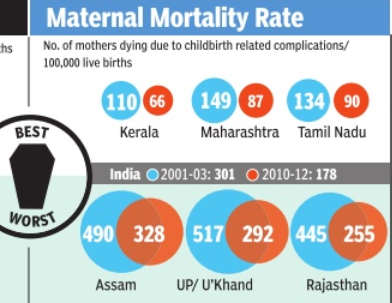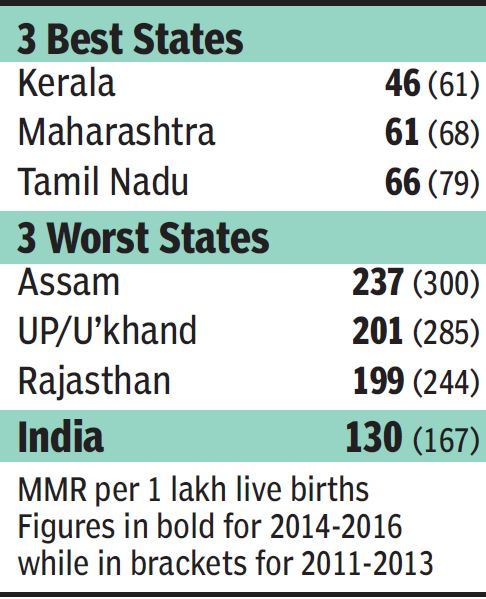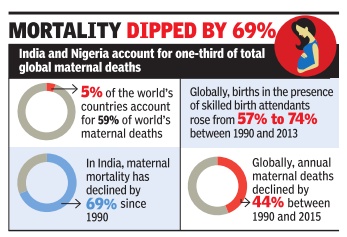Maternal mortality rate: India

This is a collection of articles archived for the excellence of their content.
|
Contents |
The extent of the problem
2011-16/ reduction from 167 to 130
Sushmi Dey, June 7, 2018: The Times of India

From: Sushmi Dey, June 7, 2018: The Times of India
HIGHLIGHTS
Maternal deaths in India have reduced from 167 in 2011-13 to 130 (per 100,000 live births) in 2014-16
Maternal and child mortality and morbidity are considered key health indicators as they reflect the state of female healthcare
India has registered significant improvement in an area where it has lagged — maternal deaths have reduced from 167 in 2011-13 to 130 (per 100,000 live births) in 2014-16 with Kerala leading the table, according to new data released by the registrar general of India.
The maternal mortality ratio (MMR) provides a measure of the quality of safe deliveries and maternal care and India's healthcare services have lagged in this respect in comparison to neighbours like China, Sri Lanka and Maldives.
The decline has been most significant in the "empowered action group (EAG)" states and Assam, from 246 to 188, in the last three years. These are states where economic and development indicators are a particular concern, like Bihar, Chhattisgarh, Jharkhand, Madhya Pradesh, Odisha, Rajasthan, Uttarakhand and Uttar Pradesh.
Among the southern states, the decline is from 93 to 77 and in the other states from 115 to 93. The heartening statistics point to steady gains, likely linked to more focused efforts to improve maternal care and rising number of institutional deliveries and more attention to health protocols.
As compared to other states, MMR continues to be substantially high in EAG states despite the drop. Assam still recorded the highest maternal death ratio at 237, though down from 300 in 2011-13. Similarly, UP and Uttarakhand registered an MMR of 201, down from 285 in the last three years.
Kerala has turned in a stellar performance, in what can be seen as evidence of a robust public health system as well as high levels of education and awareness, with the lowest MMR of 46, falling from 61 in 2011-13.
Apart from Kerala, Tamil Nadu and Andhra Pradesh also performed well after recording MMR of 66 and 74, respectively.
2015: Considerable improvement

The Times of India
Despite maternal mortality rate coming down to half worldwide since 1990, India accounts for 15% of such casualties during pregnancy and childbirth with 45,000 maternal deaths in 2015, according to a new global report by Lancet which points out international as well as national disparities in maternal healthcare services.
Despite making significant progress in reducing its maternal mortality by 69% since 1990, India along with Nigeria accounted for one-third of the global maternal deaths in 2015, the report says while attributing it to a yawning gap in maternal healthcare between urban and rural areas.
The report also highlights global inequalities by pointing at varying maternal mortality across countries. It shows that the gap between the group of countries with the lowest and highest rates of maternal mortality has doubled between 1990 and 2013.
Globally , the annual number of maternal deaths per 100,000 live births dropped by 44% between 1990 and 2015, from 385 to 216. The sub-Saharan African region accounted for an estimated 66% (201,000) of global maternal deaths, followed by southern Asia at 22% (66,000 deaths). In fact, only 5% of the world's countries accounted for 59% of the total maternal deaths globally .
“However, alongside the increasing gaps between different countries, the potential for growing inequities within countries also exists, spatially in terms of rural and urban areas or remote districts, and between population subgroups,“ the report further says.
The report a series of six papers published in the Lancet analysed different aspects and issues of maternal health globally . Despite improvement in coverage of institutional deliveries and skilled birth attendants, India has twice missed its millennium development goals to reduce maternal mortality rate by three quarters. Currently , India's maternal mortality rate stands at 174 and to achieveits next target, it needs to reduce it to 103.
Experts say that coverage of life saving interventions and inequity are two of the biggest hindrances in India for improving maternal healthcare.
The health ministry has introduced as well as expanded coverage of various schemes to address these challenges, with its main focus on remote areas . It has also started some new schemes to provide care to the pregnant women at different stages of pregnancy .